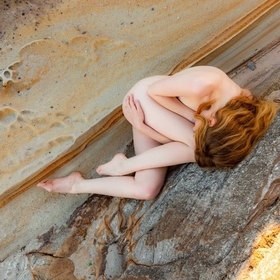

stephenwong
FollowViews
769
Likes
Awards
Winner in in the woods today Photo Challenge
Peer Award
Outstanding Creativity
Top Choice
Absolute Masterpiece
Superb Composition
Same photographer See allBehind The Lens
Behind The Lens
Location
This photo was made in the Australian bush at a national park about 15 minutes drive from my home.Time
It was early afternoon on a beautiful, sunny late autumn day. The rock and ferns were in shade, so I used off-camera Speedlites to create the illusion of sunlight. I wanted an implied nude image, so I took advantage of the vegetation to provide cover and to serve as foreground elements.Lighting
When shooting images with flash, understand that you have two different light sources to consider - the ambient light and the light from the Speedlites. I usually start of by exposing for the ambient light only. Once I have the ambient light settings worked out, then I added flash. I always shoot with the Speedlites in manual mode instead of ETTL. I find that I get better, more consistent control and it is easier to reproduce the lighting effects. For me, ETTL is too unpredictable. I frequently shoot at high shutter speeds (up to 1/8000 sec) to control the amount of ambient light, especially when I'm using a wide aperture to get good bokeh. So I use the high-speed sync feature on the Speedlites regularly. The disadvantage of high-speed sync is that you lose about 2 stops of power, so I use multiple Speedlites to compensate.Equipment
I used a Canon 5D Mark III camera and a Canon EF24-70mm f/2.8L II USM lens, fitted with a Canon Speedlite Transmitter ST-E3-RT. A Canon Speedlite 600EX-RT was mounted on a Manfrotto NanoPole Stand. Camera settings: Manual mode, 1/800 sec, f/2.8, ISO 400. Speedlite on manual mode, high-speed sync, 1/2 power ( I think).Inspiration
I love shooting nude landscapes. There's something universally appealing about contrasting the beautiful, soft curves of the female figure against the harsh, rugged textures of the environment. Sometimes, it's a natural setting, other times it's a man-made structure, like an old or abandoned building. In this particular case, the lush fern leaves seemed to be the perfect prop for the photo.Editing
Post-processing of the RAW image was done in Adobe Photoshop Lightroom. I increased the exposure and contrast slightly, decreased the highlights and increased the shadows by a small amount, and set the colour balance to 6,500K (cloudy) to warm up the image. I also removed a few blemishes from the model with the spot removal tool.In my camera bag
Shooting on location means that I have to keep my equipment to a minimal. Because I don't have an assistant, I don't use reflectors. Instead, I use Speedlites to control lighting. So in my bag, I have two camera bodies, a 24-70mm lens, a 70-200mm lens, a light meter, a Speedlite transmitter, and five Speedlites. Separately, I carry a carbon fibre tripod, a compact light stand, and a quad flash bracket for attaching four Speedlites. I don't use umbrellas or softboxes. In addition, I carry lots of spare rechargeable batteries for camera and Speedlites, plenty of memory cards, and cleaning accessories.Feedback
I think it's important to have a general idea of what you want to create. I prefer not to have a specific vision. I find that too restrictive. I like to explore the location and be inspired by the environment and the lighting conditions. Working with a good model is extremely important. It is very much a collaborative effort. Good communications with the model is vital, so that she (or he) understands the vision that you are trying to achieve. I love using a shallow depth of field. As you'll see in the image, the leaves in the foreground and the rocks in the background are out of focus, and this create the illusion of depth.
















